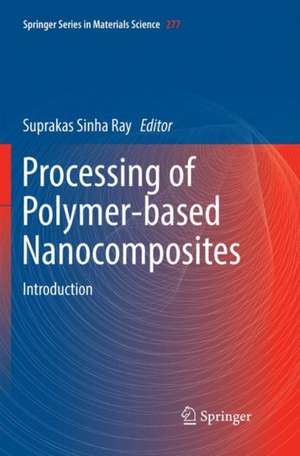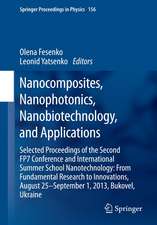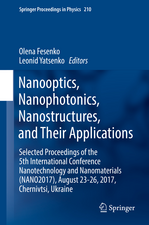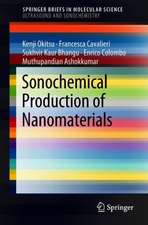Processing of Polymer-based Nanocomposites: Introduction: Springer Series in Materials Science, cartea 277
Editat de Suprakas Sinha Rayen Limba Engleză Paperback – 14 dec 2018
Processing of polymer nanocomposites usually requires special attention since the resultant structure—micro- and nano-level, is directly influenced by among other factors, polymer/nano-additive chemistry and the processing strategy. This book consolidates knowledge, from fundamental to product development, on polymer nanocomposites processing with special emphasis on the processing-structure-property-performance relationships in a wide range of polymer nanocomposites. Furthermore, this book focuses on emerging processing technologies such as electrospinning, which has very exciting applications ranging from medical to filtration. Additionally, the important role played by the nanoparticles in polymer blends structures has been illustrated in the current book, with special focus on fundamental aspects and properties of nanoparticles migration and interface crossing in immiscible polymer blend nanocomposites.
This book introduces readers to nanomaterials and polymer nanocomposites processing. After defining nanoparticles and polymer nanocomposites and discussing environmental aspects, the second chapter focuses on the synthesis and functionalization of nanomaterials with applications in polymers. A brief overview on nanoclay and nanoclay-containing polymer nanocomposites is provided in third chapter. The fourth chapter provides an overview of the polymer nanocomposites structural elucidation techniques, such as X-ray diffraction and scattering, microscopy and spectroscopy, rheology. The fifth chapter is dedicated to the polymer nanocomposites processing technologies, among which electrospinning, which has very exciting applications ranging from medical to filtration. The last chapter provides an overview on how melt-processing strategy impact structure and mechanical properties of polymer nanocomposites by taking polypropylene-clay nanocomposite as a model system.
The book is useful to undergraduate and postgraduatestudents (polymer engineering, materials science & engineering, chemical & process engineering), as well as research & development personnel, engineers, and material scientists.
| Toate formatele și edițiile | Preț | Express |
|---|---|---|
| Paperback (2) | 549.02 lei 38-44 zile | |
| Springer International Publishing – 14 dec 2018 | 549.02 lei 38-44 zile | |
| Springer International Publishing – 28 dec 2018 | 638.11 lei 6-8 săpt. | |
| Hardback (2) | 640.37 lei 6-8 săpt. | |
| Springer International Publishing – 20 sep 2018 | 640.37 lei 6-8 săpt. | |
| Springer International Publishing – 27 sep 2018 | 644.30 lei 6-8 săpt. |
Din seria Springer Series in Materials Science
- 18%
 Preț: 1820.22 lei
Preț: 1820.22 lei - 18%
 Preț: 776.09 lei
Preț: 776.09 lei - 24%
 Preț: 689.69 lei
Preț: 689.69 lei - 18%
 Preț: 968.96 lei
Preț: 968.96 lei - 20%
 Preț: 568.95 lei
Preț: 568.95 lei - 18%
 Preț: 953.65 lei
Preț: 953.65 lei - 18%
 Preț: 902.36 lei
Preț: 902.36 lei - 18%
 Preț: 953.65 lei
Preț: 953.65 lei - 20%
 Preț: 948.42 lei
Preț: 948.42 lei - 18%
 Preț: 1143.07 lei
Preț: 1143.07 lei - 18%
 Preț: 1111.53 lei
Preț: 1111.53 lei - 18%
 Preț: 1103.62 lei
Preț: 1103.62 lei - 18%
 Preț: 1225.94 lei
Preț: 1225.94 lei -
 Preț: 473.91 lei
Preț: 473.91 lei - 18%
 Preț: 782.42 lei
Preț: 782.42 lei -
 Preț: 433.47 lei
Preț: 433.47 lei - 18%
 Preț: 1116.40 lei
Preț: 1116.40 lei - 18%
 Preț: 946.24 lei
Preț: 946.24 lei - 18%
 Preț: 945.20 lei
Preț: 945.20 lei - 18%
 Preț: 1114.21 lei
Preț: 1114.21 lei - 15%
 Preț: 641.20 lei
Preț: 641.20 lei - 18%
 Preț: 958.56 lei
Preț: 958.56 lei - 18%
 Preț: 1224.36 lei
Preț: 1224.36 lei - 15%
 Preț: 644.82 lei
Preț: 644.82 lei - 24%
 Preț: 833.45 lei
Preț: 833.45 lei - 24%
 Preț: 1060.36 lei
Preț: 1060.36 lei - 18%
 Preț: 964.10 lei
Preț: 964.10 lei - 18%
 Preț: 1224.36 lei
Preț: 1224.36 lei - 18%
 Preț: 1221.20 lei
Preț: 1221.20 lei - 18%
 Preț: 946.87 lei
Preț: 946.87 lei - 18%
 Preț: 1836.92 lei
Preț: 1836.92 lei - 15%
 Preț: 643.34 lei
Preț: 643.34 lei - 18%
 Preț: 1246.32 lei
Preț: 1246.32 lei - 18%
 Preț: 956.81 lei
Preț: 956.81 lei - 18%
 Preț: 953.52 lei
Preț: 953.52 lei - 15%
 Preț: 637.59 lei
Preț: 637.59 lei
Preț: 549.02 lei
Preț vechi: 686.28 lei
-20% Nou
Puncte Express: 824
Preț estimativ în valută:
105.07€ • 114.09$ • 88.26£
105.07€ • 114.09$ • 88.26£
Carte tipărită la comandă
Livrare economică 18-24 aprilie
Preluare comenzi: 021 569.72.76
Specificații
ISBN-13: 9783030074029
ISBN-10: 3030074021
Pagini: 156
Ilustrații: XIII, 156 p. 72 illus., 61 illus. in color.
Dimensiuni: 155 x 235 mm
Ediția:Softcover reprint of the original 1st ed. 2018
Editura: Springer International Publishing
Colecția Springer
Seria Springer Series in Materials Science
Locul publicării:Cham, Switzerland
ISBN-10: 3030074021
Pagini: 156
Ilustrații: XIII, 156 p. 72 illus., 61 illus. in color.
Dimensiuni: 155 x 235 mm
Ediția:Softcover reprint of the original 1st ed. 2018
Editura: Springer International Publishing
Colecția Springer
Seria Springer Series in Materials Science
Locul publicării:Cham, Switzerland
Cuprins
Introduction, Vincent Ojijo and Suprakas Sinha Ray.- Synthesis and functionalization of nanomaterials, Neeraj Kumar and Suprakas Sinha Ray.- Nanoclay and nanoclay-containing polymer nanocomposites, Suprakas Sinha Ray and Vincent Ojijo.- Polymer nanocomposites structural and morphological elucidation techniques, Jayita Bandyopadhyay and Suprakas Sinha Ray.- Polymer nanocomposites processing technologies, Suprakas Sinha Ray and Vincent Ojijo.- Impact of melt-processing strategy on structural and mechanical properties: Clay-containing polypropylene nanocomposites, Dimakatso Morajane, Jayita Bandyopadhya, Vincent Ojijo and Suprakas Sinha Ray.
Notă biografică
Professor Suprakas Sinha Ray was born in 1973 in India and completed his PhD studies at the University of Calcutta in 2001, and then postdoctoral fellow at Toyota Technological Institute and Laval University studying the structure-property relationship in nanoclay-containing polymer nanocomposites. He started working on fundamental understanding to real applications of polymer-based nanostructured materials when he joined the CSIR as a group leader. These studies advanced and broadened when he appointed as a chief researcher (level II, highest SET position in CSIR) and director of the DST-CSIR National Centre for Nanostructured Materials and growing to the present time with postdoctoral fellows, students, collaborators and industrial partners worldwide. Currently, more than 80 researchers, engineers and technologists are working with him. Prof. Ray is one of the most active and highly cited authors (his articles have been cited more than 14700 times, google scholar, h factor 44, Google/Scopus, S.S.Ray, S. Sinha Ray, S. Sinha-Ray), in the field of soft-nanostructured materials and his work has been featured on various international journal cover pages on 14 different occasions. Recently, he has been rated as a Top 1% of most impactful and influential scientists (Chemistry, Materials Science and 22 Science disciplines) by Thomson Reuters Essential Science Indicators, 2014. In 2011, he also has been rated as a Top 50 high impact chemist in the world (Feb. 2011, Thomson Reuter, probably youngest researcher in this list, 1.2 mil Chemists). So far he has given more than 30 plenary/keynote/invited presentations in various international conferences and organized/co-organized a number of international conferences. Ray is the author of 2 books, 16 book chapters on various aspects of polymer-based nano-structured materials & their applications, and author and co-author of 250 articles (including 17 review articles) in high-impact international journals, 14 articles in peer-review international conference proceedings; 30 articles in national and international conference proceedings. He also has 4 patents and 7 new demonstrated technologies shared with colleagues, collaborators and industrial partners. His team also commercialized 16 different grades of polylactide nanocomposites. Over the last 10 years, 32 PhD/Master students graduated under his direct supervision. Currently, he is serving as an Associate Editor/Editorial Board member of the RSC Advances, Macromolecular Materials and Engineering, Applied Nanoscience, Journal of Nanoscience and Nanotechnology, International Journal of Plastic Films and Sheeting, Applied Nanoscience, Journal of Nanomaterials, and Heliyon.
Textul de pe ultima copertă
Processing of polymer nanocomposites usually requires special attention since the resultant structure—micro- and nano-level, is directly influenced by among other factors, polymer/nano-additive chemistry and the processing strategy. This book consolidates knowledge, from fundamental to product development, on polymer nanocomposites processing with special emphasis on the processing-structure-property-performance relationships in a wide range of polymer nanocomposites. Furthermore, this book focuses on emerging processing technologies such as electrospinning, which has very exciting applications ranging from medical to filtration. Additionally, the important role played by the nanoparticles in polymer blends structures has been illustrated in the current book, with special focus on fundamental aspects and properties of nanoparticles migration and interface crossing in immiscible polymer blend nanocomposites.
This book introduces readers to nanomaterials and polymer nanocomposites processing. After defining nanoparticles and polymer nanocomposites and discussing environmental aspects, the second chapter focuses on the synthesis and functionalization of nanomaterials with applications in polymers. A brief overview on nanoclay and nanoclay-containing polymer nanocomposites is provided in third chapter. The fourth chapter provides an overview of the polymer nanocomposites structural elucidation techniques, such as X-ray diffraction and scattering, microscopy and spectroscopy, rheology. The fifth chapter is dedicated to the polymer nanocomposites processing technologies, among which electrospinning, which has very exciting applications ranging from medical to filtration. The last chapter provides an overview on how melt-processing strategy impact structure and mechanical properties of polymer nanocomposites by taking polypropylene-clay nanocomposite as a model system.
The book is useful to undergraduate and postgraduatestudents (polymer engineering, materials science & engineering, chemical & process engineering), as well as research & development personnel, engineers, and material scientists.
Caracteristici
Provides a comprehensive coverage of the processing technologies, including emerging ones such as electrospinning Discusses structural elucidation techniques, such as x-ray diffraction and scattering, microscopy and spectroscopy, rheology Describes the tools used for characterization of the level of dispersion of the nanoparticles in a polymer matrix, the resultant structure and properties Explains not only the functions of the nano-additives for polymers, but also the synthesis process and their functionalization






















